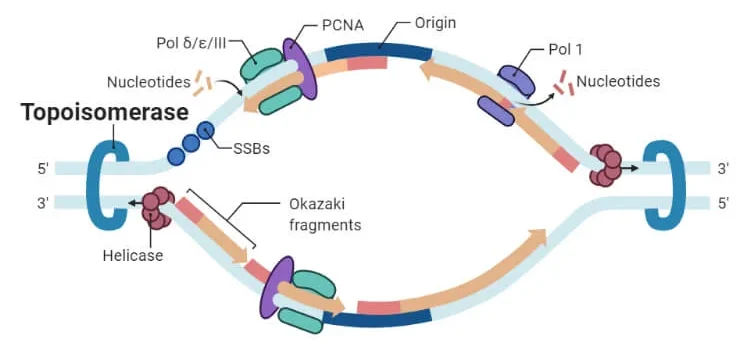
Topoisomerase
- DNA ek straight seedhi line nahi hoti — cell ke andar yeh supercoiled, twisted, aur tightly packed hoti hai.
- Jab bhi DNA open hota hai (replication, transcription ya repair ke time), double helix ke aage ka hissa overwound ho jata hai — jaise phone cord twist ho jaye.
- Isse torsional stress hota hai jo process ko rok sakta hai ya DNA ko damage kar sakta hai.
Topoisomerases ek type ke DNA untangling enzymes hote hain jo:
-
DNA ko temporarily cut karte hain (1 ya 2 strands).
-
DNA ko move hone dete hain taaki twist, knots, ya tangles remove ho jaye.
-
Cut hone ke baad DNA ko wapas reseal kar dete hain without mistake.
Agar yeh enzymes na ho:
-
DNA itna twist ho jayega ki replication aur transcription ruk jayenge.
-
Replication ke baad chromosomes linked rahenge aur cell division possible nahi hoga.
Short yaad rakhne ka tarika:
-
Type I = 1 strand cut karta hai (ATP ka use usually nahi).
-
Type II = 2 strands cut karta hai (ATP lagta hai).

Topoisomerase Types
| Feature | Type I | Type II |
|---|---|---|
| DNA strands cut | 1 | 2 |
| ATP use | Nahi (except reverse gyrase) | Haan, lagta hai |
| DNA movement | Single-strand rotation ya passage | Double-strand passage |
| Kaam | Supercoil relax karna | Supercoil relax + untangle DNA + kabhi introduce supercoils |
Type I Topoisomerase
Ek aisa enzyme jo ek strand cut karta hai, DNA ko rotate/passage allow karta hai aur phir reseal karta hai.
Structure
-
Mostly single protein chain.
-
Active site mein tyrosine hota hai jo DNA backbone se bond banata hai.
-
DNA ko grip karne wala groove hota hai.
Types
-
Type IA – sirf negative supercoils relax karta hai; 5′-phosphotyrosyl linkage banata hai; ssDNA region chahiye.
-
Type IB – positive & negative dono supercoils relax karta hai; 3′-phosphotyrosyl linkage banata hai; DNA freely rotate hota hai.
-
Type IC – mostly archaea mein; IB jaise kaam karta hai lekin structure alag hota hai.
Example – Type IA (E. coli Topo I)
-
Negative supercoils control karta hai.
-
Gyrase ke saath balance maintain karta hai.
-
Topo III recombination mein special role leta hai.
Mechanism (Type IB – Free Rotation)
-
DNA bind hota hai.
-
Tyrosine DNA backbone cut karta hai → 3′-phosphotyrosyl bond.
-
Cut end rotate hota hai stress relieve karne ke liye.
-
DNA reseal hota hai.
Type II Topoisomerase
Yeh 2 strands ek saath cut karta hai, ek dusra double-stranded segment us gap se pass karta hai, aur phir DNA reseal karta hai. ATP lagta hai.
Structure
-
Usually dimer ya tetramer.
-
3 regions:
-
ATPase domain – ATP bind & hydrolyze.
-
DNA-cleavage core – active site tyrosines.
-
C-terminal domain – DNA recognition.
-
Types
-
Type IIA: DNA gyrase, Topo IV, eukaryotic Topo IIα/β.
-
Type IIB: Topo VI (archaea/plants).
Mechanism (Simple Steps)
-
G-segment bind hota hai.
-
ATP bind karke T-segment capture hota hai.
-
G-segment ke dono strands cut hote hain.
-
T-segment us cut gap se pass hota hai.
-
G-segment reseal hota hai.
-
ATP hydrolyze hota hai → enzyme reset.
Topoisomerase Inhibition
Type I Inhibitors (Cancer Drugs)
-
Camptothecin, Topotecan, Irinotecan.
-
Mechanism: Topo I–DNA cut complex ko stabilize karte hain → replication se collision → double-strand breaks → cell death.
Type II Inhibitors (Cancer Drugs)
-
Etoposide, Teniposide, Doxorubicin.
-
Mechanism: Resealing block kar dete hain → DNA breaks.
Bacterial Topo II Inhibitors
-
Fluoroquinolones (ciprofloxacin, levofloxacin) – gyrase & Topo IV target.
-
DNA breaks cause karke bacteria mar jata hai.
Clinical Significance
-
Cancer therapy: Rapidly dividing cells kill karte hain.
-
Antibiotics: Bacterial enzymes ko target karte hain, human enzymes safe rehte hain.
-
Resistance: Binding site mutation, drug efflux pumps, protective proteins.
Topoisomerase vs Helicase
| Feature | Topoisomerase | Helicase |
|---|---|---|
| Kaam | Supercoil remove karna, DNA untangle karna | DNA strands ko unwind & separate karna |
| Action | DNA cut (1 ya 2 strands), movement allow, reseal | Hydrogen bonds todke strands alag |
| ATP use | Type I: no, Type II: yes | Haan, ATP lagta hai |
| Kab kaam karta hai | Replication fork ke aage, transcription bubble, chromosome segregation | Replication fork par strand opening |
| Direction | Direction-specific nahi | 5′→3′ ya 3′→5′ direction mein move |
| Effect | DNA topology change karta hai | Single-stranded template banata hai |
| Coordination | Helicase ke saath kaam karta hai | Topoisomerase ke saath kaam karta hai |
Topoisomerase vs Gyrase
| Feature | Topoisomerase (General) | DNA Gyrase |
|---|---|---|
| Definition | DNA topology change karne wala enzyme | Bacterial Type II topoisomerase jo negative supercoils introduce karta hai |
| Occurrence | Har organism mein | Sirf bacteria & kuch archaea |
| Types | Type I & II | Type II only |
| Supercoil ka kaam | Mostly relax karta hai | Negative supercoil introduce karta hai |
| ATP use | Type I: nahi, Type II: haan | Haan |
| Functions | Stress relieve, untangle, decatenate | DNA compact karna, replication help |
| Drug target | Cancer & antibacterial drugs | Fluoroquinolone antibiotics ka main target |
| Human presence | Haan | Nahi – isliye selective drug target hai |